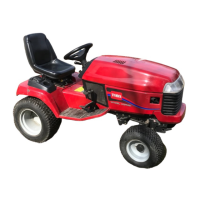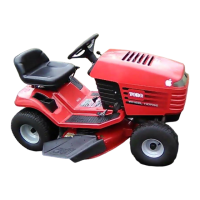Maintenance
31
Checking the Spark Plug
1. Look at the center of the spark plug(s) (Fig. 10).
If you see light brown or gray on the insulator,
the engine is operating properly. A black
coating on the insulator usually means the air
cleaner is dirty.
IMPORTANT: Never clean the spark plug(s).
Always r
eplace the spark plug(s) when it has:
a black coating, worn electrodes, an oily film,
or cracks.
2. Check the gap between the center and side
electrodes (Fig. 10). Bend the side electrode
(Fig. 10) if the gap is not correct.
0.030”
(.762
mm)
2
3
1
Figure
10
1. Center
electrode insulator
2.
Side electrode
3.
Air gap (not to scale)
Installing the Spark Plug(s)
1. Install the spark plug(s). Make sure the air gap
is set correctly.
2. Tighten the spark plug(s) to 15 ft–lb (20.4 Nm).
3. Push the wire(s) onto the spark plug(s) (Fig. 9).
Greasing
and Lubrication
Service Interval/Specification
Grease the machine after every 25 operating hours or
yearly, whichever occurs first. Grease more
frequently when operating conditions are extremely
dusty or sandy.
Grease Type: General-purpose grease.
How to Grease
1. Disengage the power take off (PTO), set the
parking brake, and turn the ignition key to
“OFF” to stop the engine. Remove the ignition
and “key choice” keys.
2. Clean the grease fittings with a rag. Make sure
to scrape any paint off the front of the fitting(s).
3. Connect a grease gun to the fitting. Pump grease
into the fittings until grease begins to ooze out of
the bearings.
4. Wipe up any excess grease.
Where to Add Grease
1. Lubricate the front wheels and spindles until
grease begins to ooze out of the bearings
(Fig. 11).
Figure 1
1
2. The rear wheels should be removed and axles
greased once a year to prevent the formation of
rust and to simplify future wheel removal.

